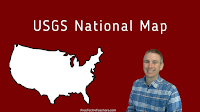Click here to read this mailing online.
Here are the latest updates for nurhasaan10@gmail.com "Free Technology for Teachers" - 3 new articles
The Geography of Baseball FansThe Major League Baseball season started yesterday. This morning while I was flipping through some highlights of yesterday's games, I was reminded of a neat map that I cam across a few years ago. SeatGeek's interactive map titled Where do MLB Fans Live? is an interactive map that shows which teams are the most popular teams in each county in the United States. A few things found through the map were not surprising at all. For example, every county in Maine and New Hampshire the Red Sox are the most popular team. And a few things revealed in the map did surprise me. For example, growing up in Connecticut I always felt like the state was evenly divided between Yankees and Red Sox fans (with a few oddball Mets fans sprinkled in), but according to this map the state is predominantly a Red Sox state. Create Your Own USGS MapsEarlier this year I highlighted the galleries of free to use and re-use media that the USGS hosts. Earlier this week I was back on the USGS site looking in those galleries when I noticed something new to me. That something is the USGS National Map Viewer. Don't the name fool you, the USGS National Map Viewer is more than just a place to look at a map. The USGS National Map Viewer lets you choose from a huge library of datasets to display on a map. You can view the source information for each dataset. Additionally, you can choose the base map on which the datasets are displayed. If that's not enough to get you to try the USGS National Map Viewer, I should also tell you that you can draw on the maps, measure on the maps, and print your customized map displays. Watch this short video to get an idea of what is possible with the USGS National Map Viewer. Applications for Education The USGS National Map Viewer could be a great tool for students to use to make visual connections between the information provided in a dataset and the locations referenced in those datasets. For example, in the video above I applied the earthquake faults dataset to the map so that students can see where there is more or less seismic activity in the United States. On a related note, here's a nearly realtime USGS map of the latest seismic activity around the world. 50 Tech Tips and a Tech Tuesday WebinarEvery month this year I've hosted a webinar for people who have purchased a copy of 50 Tech Tuesday Tips. I'm doing the same again next week. On April 12th at 4pm ET I'm hosting A Framework for Technology Integration. Anyone who purchases a copy of my eBook between now and midnight (Eastern Time) on April 11th will get a link to join the webinar. And if you previously purchased a copy and want to join this webinar, just send me a note and I'll register you. In A Framework for Technology Integration I'll share my framework for helping teachers use technology in meaningful ways in their classrooms. I'll also provide some examples of how I've done it in the past and how you can replicate them in your school. About the eBook:50 Tech Tuesday Tips was curated from more than 400 editions of The Practical Ed Tech Newsletter. 50 Tech Tuesday Tips provides you with ideas for lots of helpful things that you can teach to your colleagues and to students. Throughout the eBook you'll find tutorials and handouts that you can pass along in your school. Some of the many things you'll find in 50 Tech Tuesday Tips include:
Get your copy of 50 Tech Tuesday Tips right here! No, this ebook isn't free but the tools that feature within it is free to use. Creating something like this takes many, many hours but reading it can save you many, many hours. Purchases of 50 Tech Tuesday Tips make it possible for me to create other free resources like The Practical Ed Tech Handbook that I update and give away to thousands of teachers every year. More Recent Articles |
« Prev Post
Next Post »




.png)

ConversionConversion EmoticonEmoticon